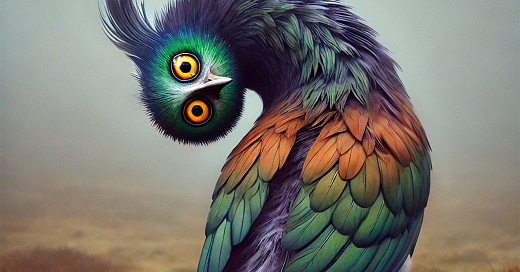Myth of the Day: Oozlum bird
In the whimsical world of British naval folklore, the Oozlum Bird is a backward-flying avian oddity, a humorous reflection of human quirks.
Region/Culture: England, Northern Europe
Mythos: English Mythology
Primary Type/Nature: Fairy Folk and Spirit Beings
Mythical Attributes: Known for flying backwards to keep dust out of its eyes.
Role in Mythos: Though not part of any formal mythological narrative, the Oozlum bird serves as a humorous emblem of absurdity or paradox in British naval folklore.
Relation to Humans: The bird is often cited in stories to exemplify foolishness or paradoxical situations. Its disappearance by flying in ever-decreasing circles until it disappears into itself is sometimes invoked as an amusing metaphor for self-destructive or pointless human behavior.
The oozlum bird, a creature born of wit and whimsy, flits about the annals of Australian and British folklore with a flair for the absurd. Its most celebrated behavior is a final, self-absorbed vanishing act—flying in ever-tightening circles until it disappears up its own posterior, a feat that renders it both impossible to capture and a symbol of hilariously inevitable self-destruction. Whether this end is born of panic, vanity, or sheer existential absurdity depends on the teller of the tale, but all agree: the oozlum bird is a marvel of mythical nonsense.
In appearance, the oozlum bird is said to boast feathers of such brilliance that they rival the finest plumage in nature, although specific descriptions vary wildly. Some accounts liken its coloration to a riot of jewels, shimmering with a brilliance too radiant for mortal eyes. Others propose a less ostentatious form, its beauty hinted at rather than overtly proclaimed, as though it were in on its own cosmic joke. Regardless of its physical attributes, the bird’s most defining feature is not its body but its behavior. In some versions of the legend, it flies backwards, determined to keep its own glorious tail in view. “Where it has been,” so the story goes, “matters more than where it is headed.”
The origins of the oozlum bird’s myth are as murky as the bird’s fate is ludicrous. Some speculate its name may be derived from “ouzel,” an old term for a blackbird, though any physical resemblance stops there. The bird’s antics likely emerged as a satirical reflection of human folly, an emblem of circular reasoning, vanity, and the tendency to self-sabotage in pursuit of the inconsequential. Over time, the oozlum bird has found its way into jokes, poems, and even films, perpetuating its peculiar charm through generations.
Among the many tales associated with the bird, W.T. Goodge’s poem “The Oozlum Bird” takes flight with peculiar grandeur. Here, the oozlum bird not only flies backwards but also defies the laws of physics, remaining airborne while the earth spins beneath it. In this version, the bird is no mere curiosity but a creature of such size and strength that it could carry a man on its back—a fantastical steed for those with dreams as whimsical as its flight patterns.
Special powers? The oozlum bird has them in spades, though none are remotely practical. It can fly backwards, circle itself into oblivion, and apparently shrug off gravity at will. These abilities, however, come with a fatal flaw: an insatiable urge toward self-destruction. Whether motivated by sheer vanity or an innate predilection for paradox, the bird’s inevitable disappearance is both its crowning glory and its undoing.
Yet, for all its absurdity, the oozlum bird carries with it a subtle warning. Its legend teases us for our own circular arguments, our blind self-obsession, and our knack for missing the bigger picture in favor of admiring our own proverbial tail feathers. If the oozlum bird could speak, perhaps it would offer no wisdom at all—just a backward glance and a knowing chuckle before it spirals out of existence.
Suggested Further Reading
If you enjoy our content, please consider making a donation to support the people of Ukraine. Click here to visit the official Ukrainian donation website.
Explore more myths and wonders by visiting godsandmonsters.info.
Enjoy mythic tales on the move with our podcast, Five Minute Mythology.




